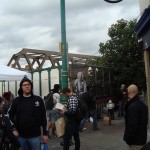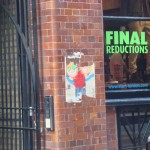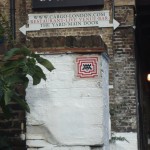September 19th, 2010 · No Comments
This is a very long post because I am really, really excited about it. If you don’t feel like reading the entire thing, the part that is relevant to England is just in the section labeled “analysis” at the bottom.
While several other people from our group were off being awesome and seeing the Pope yesterday (I’m still really jealous), there was a scientology protest on Tottenham Court right across the street from the Scientology clinic, complete with V for Vendetta masks, megaphones, picket signs, and a lot of bizarre internet references. This is pretty much a dream for someone like me because it combines angry protestors, really odd subcultures, and a religion that allegedly contains aliens. (I know, right?! Better than Bedlam with psych wards, cannibals, and feminism). So I got a chance to talk to the scientologists inside the clinic for a while, and then I talked to a few of the protestors across the street, one of whom was a rogue scientologist. He termed himself a “squirrel,” which is a person who still believes in the axioms of scientology but has disconnected himself from the establishment.
Anyway, I’m not sure how familiar most people are with scientology. I already knew a lot of the social issues surrounding it because of media coverage, but I’ve never gotten an account of the belief system from an actual scientologist. I’ll give a rundown of the things I thought were important:
Part 1: The woman I spoke to inside the clinic was a little odd, but perfectly happy to talk to me, show me informational films, and give me free literature. She did not attempt to sell me anything, give me a diagnostics test that would tell me I was depressed and should pay her a bunch of money, or otherwise brainwash me. I asked her what she thought about the press coverage of scientology and the allegations that it’s exploitative, and she genuinely didn’t seem to have any knowledge of abuse to people within the church or a pyramid scheme going on. So I’m going to assume she was a believer rather than a person at the head of the church making a ton of money.
According to what she told me, L. Ron Hubbard is the founder of Scientology, but only a man rather than a prophet. He has written all the scriptures (which are read at services on Sundays just like many other religions), the main one being The Thesis of Dianetics. He also wrotes the prayers. I found this interesting because every religion I’ve ever studied has holy scriptures directly from God(s) or a prophet and then some have other important documents written and axioms written by men.
When I asked her about her conversion, she said that she never converted because Scientology is supposed to be addition rather than a superseder of other religions. She was also Catholic and often attended Catholic masses when she was with her parents. This means that scientologists do not officially evangelize. Scientology is also apolitical apparently, no official stances on abortion.
I also asked her about the religion itself. Firstly, no aliens, apparently (disappointing). No mention of Xenu. Thetans, she said, are basically an equivalent to the soul except rather than saying you have a soul/thetan, the soul/thetan is you. There is a trinity of self composed of mind, body, and soul/thetan. The thetan returns after your death, so Scientology is a religion of reincarnation. There are eight dynamics of life which become increasingly broad: self, family and all things sex related, group/friends/community, mankind, living things, physical universe, spiritual self, and infinity/supreme being. This was another detail that struck me as extremely weird because it was the only mention she ever made of God in her whole explanation. There is a whole we-are-all-connected-Lion-King motif with the dynamics, which is very familiar, but the main emphasis she placed on her explanation was self help. Scientology is supposed to allow you to rid the negative energy from your life. It focuses heavily on L. Ron Hubbard’s idea that the mind regulates the body, so believers go to counseling sessions where they work on different aspects of their life (communication, relationships, hostilities of life), and they ascend to different levels as they improve. You are also supposed to study. Scientology offers courses for personal betterment (you have to pay for them because there is no government funding) and you can study to become ordained, in which case you study under a superior and also ascend levels of awareness. A lot of hierarchy going on. They’re especially antidrug because they want to focus on the mind, and drugs are bodily and act as toxins.
If I had to simplify it, I would say she was focusing on psychological self help with spiritual axioms.
Part 2: The protestors outside were equally odd and equally happy to talk to me (They invited me to the pub after about an hour but my stranger danger blinker was buzzing). They are part of an internet based organization called Anonymous, which has taken Guy Fawkes from V for Vendetta as their mascot. They wear the masks so as not to be followed/sued by Scientologists. I could write a whole paper on the internet subculture surrounding this protest, but this post is already way too long. I talked to two of the few people not wearing masks, one of whom was a well researched protestor and the other a Scientologist that broke away from the church. Major issues they had:
- Pyramid scheme – Scientology is organized so that people have to pay massive amounts for counseling to ascend to the next OT (operating thetan, don’t worry, I’ll get to an explanation) level. They can only get free counseling if they agree to volunteer for the church in which case they’re working for insanely low wages, and if they decide to leave the church they must pay for all the counseling they’ve ever had in lump sum.
- The church abuses people by denying them access to medicine they need. Lisa McPherson is an example they mentioned of a woman who died. However, they place people on strong regiments of Scientology vitamins, which make them more money.
- Scientology can label any person as an SP (supressive person) or negative influence on someone within the church. If a superior labels your family member as an SP (this can be for anything, like suggesting that Scientology may be dangerous), you can no longer talk to that person.
While the woman inside said L. Ron Hubbard wrote science fiction to fund his research on the nature of man, the non-Scientologist protestor said the sci fi discredited him. The woman inside said that the church was involved with charitable works for the community and participated in interfaith organizations, but the man outside said that all Scientology’s charitable works were minimal for publicity or self-serving. An example he used was Narconon, a program in which Scientologists provide free counseling and drug rehabilitation, which allows them to pull in more people.

Picture taken from http://www.altogetherdigital.com/20080210/anonymous-vs-scientology-strange-goings-on-in-london/ (Coverage of another Scientology protest in London)
Part 3: This is about the guy who referred to himself as a “squirrel,” a Scientologist against the establishment. He told me a lot more about the way OT levels work because he had risen several levels through counseling before leaving. Thetans are not just personal souls; they’re also energy from different life forces that float around on earth and sometimes attaches to people without either being’s knowledge. Counseling allows you to cleanse yourself of thetans. He actually experienced an exorcism of a thetan as powerful as himself (he said he couldn’t believe that he was controlling his body and she wasn’t) who came back to visit him several days later. He said that he never believed Xenu, an alien in the Scientologist narrative who sent a bunch of thetans to earth’s volcanoes; he understood the story strictly as a metaphor. He did still believe in the axioms, and mention one: “Life is a static capable of postulates and considerations.”
Analysis: I can see why Scientology is so attractive to so many people. It has commonalities with a lot of different religions. The levels of awareness and cleansing are similar to levels of enlightenment in some forms of Hinduism and Buddhism. The 8 dynamics are a familiar hierarchy, and the eighth dynamic infinity/the supreme being. which encompasses everything else, also hearkens back to other religions. For instance, Islam and Judaism focus so much on the infiniteness of God that they are aniconic. You cannot depict God or speak of God without special ritual so that you are not in danger of quantifying God. The trinity of mind, body, and soul seems awefully similar to the Father, Son and Holy Spirit trinity we find in Christianity. Plus, the idea of a thetan, when we compare it to a soul, doesn’t really sound farfetched at all. Yogic Hinduism focuses on releasing negative energy akin to parasitic thetans. Muslims perform ritual purifying before every prayer. The focus on study, the fact that believers are supposed to take courses, is pretty similar to studying the Torah for bar mitvah or the Bible for confirmation.
It’s also very attractive because it reiterates a lot of popular sentiment about psychology and self help. There is already an issue with the overpresecription of drugs because drug companies have so much influence over doctors. Scientology reiterates the fear of overmedication. Western society is also a society obsessed with psychology. More people than ever see therapists. Depression has invaded so thoroughly that it is used a synonym for sadness. A religion that revolves around self help fulfills a need. Also, the fact that Scientology is a spiritual form of self-help with very little emphasis on God might be very practical for the English in particular. The census we saw notes that many English consider themselves spiritual, but do not believe in God.
The attractive part of the religion of Scientology makes the establishment of Scientology extremely terrifying because everything the protestors named had a seemingly reasonable counterpoint. Scientology could be a money making scheme, or it could be that scientology needs money to operate just like any other religious establish needs membership fees and donations to operate. Scientology does not receive government funding in England because it does not pass the means test so maybe it needs even more money (The protestors told me that the Scientology church in England gets around this by registering under Australia which has no means test, but I unfortunately can’t find any research on it). Scientology could be brainwashing people by having superiors hover over them, excommunicating their relatives, and denying them medical attention, or they could just be providing mentors and trying not to overmedicate people. Obviously, there is something wrong with an establishment that abuses people, but from the inside it’s very difficult to define abuse.
We also have to separate the religion from the establishment and look for the good. The “squirrel” I talked to felt deep spiritual benefit from belief in the 8 dynamics, counseling for communication skills, and the release of thetans and energy. None of the stories or axioms he talked about were any siller than a virgin birth, a man whose head is replaced by an elephant’s, or Muhammad splitting the moon. They’re just myths (I mean stories within a tradition, not false accounts) that create a discourse for a belief system. When I asked a man at the Hindu temple why there was a statue of Krishna and not Vishnu, he told me it was because they were the same, and that every god in the temple was a different avenue to the same God, just like there are many different Tube routes back to Tottenham Court (his analogy, not mine). Hokey, yes, but I love this sentiment because it reminds us that tolerance should extend to any path that benefits people. That does not mean we should tolerate an abusive establishment. The protestors told me that unlike America, England defines Scientology as a religion, giving them special legal rights to practice. But it does mean that we shouldn’t dismiss individuals who believe in the Scientology as wackos, especially since the its definition as a religion depends not just on its legitimacy as a belief system but the legitimacy of the establishment that endorses it.
So in summary, we should all respect each other and be friends (Please tell me if you read that entire thing, that my thesis came out to more than that).
A source recommended to me by the protestors:
Sikh comedian’s explanation of Scientology. Recommended by the “squirrel”
Tags: 2010 Jesse
September 19th, 2010 · No Comments
One of the things that has truly surprised me during our time in London and in our readings over the summer was the lack of a widespread religious sentiment and a growing secular way of thinking. Visiting the different places of worship for me has been very enriching. I sincerely enjoyed hearing about the way different roles of various institutions in their communities. Despite this growing secular sentiment, it was evident to me that faith is still an important key to Englishness. Sure, we may not have had the same treatment at the Christian institutions we visited, but we weren’t at the parish church where they would have stressed the other parts of Christianity outside of the famous dead people.
At the mandir, mosque, and synagogue, I did learn something about other faith communities, all of which I wasn’t that familiar with. Familiar with Christian outreach, it was interesting to hear the way other faiths volunteer and conduct outreach. I was also intrigued by the amount of history each guide mentioned; at the mandir, there was a specific exhibit to help you understand the history and beliefs of Hinduism. At the mosque, the guide spent more time on the basic principles, whereas at the synagogue it was much more history heavy, which I enjoyed (despite the slight mix up with who declared the crusades and who ordered Richard’s). Yet, they all stressed the importance of the community and what they did for the community. At the end of each tour, I felt that I had been where a faith was active and thriving- counteracting the general arguments we had encountered.
Before I talk about my favorite experience, I’m going to go off on a bit of rant/tangent. (Nothing unusual, you’re probably thinking.) While Christianity is undeniably not as much on the forefront as it once was (I sometimes forget I’m not in the Middle Ages where the church was as influential as those in political power and grotesques littered the cathedral for unknown reasons), it is still playing an important role in England. How? Most noticeably, the concerts we’ve attended. Sure, they haven’t been lectures in Christianity, but they have brought people into a church where they were witnessing a faith community. You don’t necessarily have to have a lecture about the religion’s history when you are there in order to spark an interest. Sometimes a few trips for concerts or to be a tourist will spark an interest and prompt someone to ask a question that leads to a serious discussion. Yes, it would have been nice to have left any of the churches/cathedrals with a pamphlet on basic Christianity, but because those audiences (presumably) weren’t there to learn about Christianity, a pamphlet may have been more alienating than encouraging.
Okay, so my favorite experience and what it taught me. Hands down, my favorite has been (no surprises) Westminster Abbey. (This may change as I’m hoping to get over to St. Bartholomew the Great tomorrow; it’s a medieval parish church.) Why when it didn’t actually teach me about Christianity or the abbey that I didn’t know? One, because it inspired my faith through the sweeping architecture and stained glass. For me, those are more impressive and awe-inspiring than St. Paul’s (in its present Wren-wrecked – okay, so maybe that’s a bit harsh-state) could ever dare to be. Two, because as a medievalist, I was able to participate in a long-standing tradition: the pilgrimage. Throughout history, people have visited sites throughout the world for many reasons. At Westminster Abbey, everything I love was combined into one place: my faith, grotesques, cosmati, saints, Chaucer, Gothic architecture, etc. I was on a pilgrimage of sorts. True I wasn’t there to pay my respects to Edward per se, but I can’t deny seeing the tomb of such an important figure didn’t give me chills (even though it’s been really messed up and reassembled incorrectly). I didn’t necessarily have to learn anything about Christianity to have an incredible experience. Yet, to say I didn’t learn anything is mistaken. I did, but I learned more about the position of the Church of England. It is clearly in decline, but the abbey is doing what it can given its monumental dual-purpose (protect priceless art and architecture while spreading its Christian message).
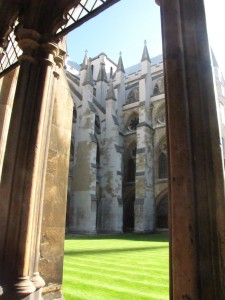
I’m sure some of us would argue that it is up to these major institutions to take the lead in revitalizing Anglicanism, and to some extent Christianity, in England. However, because Westminster Abbey stands for so much more than just Christianity (whether this is a good or bad thing is up for debate), it is important for some of the parish churches to be more vocal on these issues. For Westminster Abbey (and to some extent St. Paul’s) to take a major stand is a conflict of interests, a problem that lays at the heart of its problems rises: should it risk alienating the audience that helps it survive in order to promote its beliefs? It shouldn’t compromise its faith (and I don’t think it does; it does remain closed for services on Sundays as well as hosts small prayers and services throughout the day/week) in order to protect its architecture, nor should it compromise its architecture to protect its faith. They go hand-in-hand in many regards. Without either, you lose part of the abbey. If there was ever a lose-lose, impossible to win situation, double-edged sword, etc, this was it!
I’m hoping as I visit other major medieval cathedrals, a solution to the Christianity vs. tourism problem will become evident, but for now Westminster Abbey will have to be simply (as its Cloister represented for its medieval monks) my paradise on earth.
Tags: 2010 Stephenie · Churches and Cathedrals
September 19th, 2010 · No Comments
So, like many other people, I have noticed the difference in educational programming at the Anglican churches that we’ve visited versus the other religious centers that we’ve seen. At Westminster Abbey I enjoyed the history and all of the famous people buried there (I looked down to discover that I was standing on David Lloyd George’s grave–sorry!), and at St. Paul’s Cathedral I admired Sir Christopher Wren’s gorgeous design and thought of the five hundred stairs that awaited me. So many people have commented on this lately, but I think that Mary Kate is right when she says that we have a valuable opportunity to look at and discuss Christianity in Britain in terms of Pope Benedict XVI’s visit.
In the course of my research for our walking tour, I stumbled across an interesting opinion on the de-Christianization of the British, and it had nothing to do with immigration or the emergence of other religions. In the introduction to his book A Revolution in the Head, Ian MacDonald comments that the baby boomers were the last generation to attend church regularly, but that Christianity had been on the decline for much longer than that. MacDonald argued that science was to blame–as more and more scientific developments were made, especially in terms of medical discoveries and Charles Darwin’s theory of evolution, it became more and more difficult for people to balance this new information with Christian beliefs, and scientific ideas began to take precedence.
The more I thought about this, the more it made sense to me. As the imperial capital of the world for so many years, England was the place where so many new ideas and discoveries originated. This country, and especially London, has hosted radicals and revolutionaries in terms of politics, art, and science. If scientific ideas were going to take hold anywhere, it makes sense for it to be here. Based on what I’ve learned of the 1960s, I can also understand why the baby boomers really started moving away from religion. The Anglican Church was traditional and belonged to their parents’ generation, and the sixties were about youth making their own mark and breaking away from tradition. Religion may very well have been a partial victim of the sixties.
I’m not saying that Christianity is still a tired religion–in my experience, there has been a definite move to adapt the religion to changing times and to attract more followers. But it seems that this isn’t going so well in Europe, and one of the reasons may be the perceived gap between religious leaders and the public. To me, the fact that Cardinal Kasper called England a “Third World country” immediately before the Pope’s arrival shows amazing insensitivity to the cosmopolitan make-up of Britain’s population and ignorance as to how to reach out to people. He certainly did not do the Pope any favors in this already contested visit.
This seems to speak to what our guide at the East London Mosque was saying about the need for different religious groups to understand each other. In this case, Christian leaders perhaps need to learn how to better relate to a widely secular public, especially by not distancing them with offensive remarks. In terms of wider, inter-religious understanding, I admired our guide’s willingness to admit that education is necessary on the part of both Muslims and non-Muslims. But I was puzzled that he seemed to resist the opportunity to engage us on that level. I felt that he stereotyped us as ignorant Americans, and that we missed the opportunity for a good dialogue on some very important issues.
The religions that we’ve engaged with during the past month are all tolerant religions, but it seems to be that people need to follow their own teachings a bit better, both in terms of learning about other religions and in terms of relating to people who supposedly belong to the Church of England.
Tags: 2010 Holly · Churches and Cathedrals
September 19th, 2010 · 1 Comment
I’ll admit that I have not been to a wide variety of pubs, so I’ll have to do my best to draw conclusions from the experience I do have. I have genuinely enjoyed the ones I have been to, we’ve just been so darn busy here and I’m always so tired that I don’t go out very often. I disagree with some of my classmates who have been arguing that pubs are overpriced and that the food isn’t worth it. I actually think some of the pubs have pretty good deals. At some you can get a sandwich and chips or a sandwich and a drink for under four pounds, which is more than you can say for Pret or Sainsbury’s, depending on what you get there. The food might not be the best, and certainly not the healthiest, but on occasion I enjoy a bit of grease, and I especially like the part where you order and they bring you the food and you don’t have to do anything. Also there are chips (fries) which are my favorite food in the world.
I’ll start by comparing pubs at lunch and pubs at dinner. I’ve found that it’s a lot easier to get into pubs at lunchtime; it’s a lot less crowded. When it isn’t crowded, I feel sure that I’m not intruding or bothering anyone. Walking into a crowded pub at dinnertime or at night can be awkward because you’re unsure if all the people there already know each other or if you’ll be taking someone’s regular table or chair. It can be a bit unwelcoming.
The exception to this that I’ve found is the Court. The Court seems to cater specifically to a young, student crowd with their meal deals and discount card. Everyone seems to go there with their own group of friends and doesn’t really pay anyone else any mind. I don’t get the impression that there are “regulars” there. Students can be a bit transient. The consequences of this younger crowd, however, are extra loud American pop music, questionable wardrobes, and general drunken disorderliness. The times I’ve gone there I’ve had a good time, despite the fact that I have to shout to be heard and worry that I’m going to get beer spilled on me at any moment.
I agree with George Orwell that pubs where it is quiet and you can hear yourself talk are preferable. The Marlborough Arms has this advantage over the Court. The music is softer and there is less drunkenness. I feel generally welcome there too, although the crowd is a bit older and I do get the feeling that there are regulars, most of whom are British. I think the regular thing contributes to the different level of classiness, though. However, I also agree with Orwell that you can’t win on all counts – the food at the Marlborough Arms is more expensive.
I think as a group we are beginning to get the hang of the buying drinks in rounds thing, and some people remember to ask to buy the bartender a drink, although they usually refuse. Still, I’m not sure that we will ever fully be able to pass for being English in a pub, and I think that although we have knowledge of the general pub rules, each individual pub has its own hidden rules and traditions. I’m hoping that perhaps this will get easier when we go out with our roommates at UEA who are actually British.
Tags: 2010 Kaitlin
September 19th, 2010 · 3 Comments

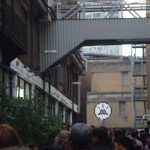
British street art is British for many reasons. First of all, it is rather egalitarian. Anyone can go up to a wall, etc. and post something. Street art also provides a sense of camaraderie and bonding the Brits so desperately desire, demonstrated in the mass art movements (in this post, the space invaders (p.s. there’s one right outside of Arran!) and einsteins-on-bikes). Though one may say that street art is generally anonymous and therefore no one gets a real sense of friendship – well, that demonstrates their social dis-ease. A sense of camaraderie without social interaction? British social utopia. These mass movements also embody the idea of fair-play, as anyone with a couple tiles (for space invaders) and anyone who can call Fatheads (large adhesive poster company, for Einstein) can contribute to these city-wide projects.
Other ways in which British street art demonstrates the conclusion section of Kate Fox’s book (and the main indicators of British social interaction and sociological thinking) are the ideas of moderation, modesty, and courtesy:
Moderation – Yes, street art in the simplest sense violates moderation. However, compared to American street art, it is very much so. A lot of American street art is gang signs, or is much more graphic (in general) than say… little weird monsters, pacman characters, or a large prelican-y looking thing. Even the famous banksy highly disguises political messages by reducing potentially graphic scenes into less explicit ones (but, at the same time, makes them all the more powerful!): http://blog.collectables-now.com/2008/01/12/bank-on-banksy/
Modesty – most British street art remains anonymous. Though there are exceptions to every rule, much of the art is left unsigned. No one still knows who Banksy, arguably the most famous street artist of all time, actually is. Looking above – clearly the squirrel and bird/pelican are of the same artist, and require a bit of skill. Neither has a signature.
Courtesy – my favorite, and in my opinion the most distinctive, aspect of British street art. A large amount of British street art is on non-permanent structures, like construction panels (see above pictures), or is either sprayed on newspapers which are then posted on walls, or are somehow non-permanent (like the einsteins, or the old woman).
Well, British street art is two things: awesome, and really British. Let me know if you find any that you think is neat, and let me hear your thoughts on whether you think it is British.
Tags: 2010 ChristopherB
September 19th, 2010 · 1 Comment
I was walking around Westminster Abbey at lunchtime today, and happened to stumble through the celebration for the seventieth anniversary of the Battle of Britain. This was a) unexpected and b) very exciting, as we were all craning for a view of the Queen (and Princes William and Harry. When in London…) We got to see a military band, as well as a division of the Royal Air Force. The most exciting part was definitely the flyover of a Spitfire and a Hurricane from the period, two planes that were very important to Britain’s victory. For more on the flyover, see this article from the BBC: http://www.bbc.co.uk/news/uk-11120357 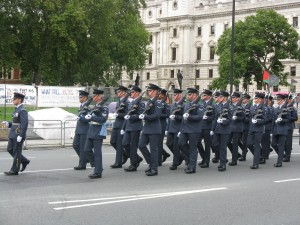

It was really interesting to see this celebration, especially since we don’t give World War II the same kind of attention in the States. It really made me realize the lasting impact that the war has had on Britain, however, especially as the procession marched past the statue of Winston Churchill outside of the Houses of Parliament.
At the same time, this was my first real brush with classism. We caught the tail end of the ceremony, so people were starting to filter out from the Abbey. The streets were completely blocked off, both for traffic and to keep tourists at bay. These physical barriers only enforced the class divisions that were already on display. Everyone leaving the Abbey was dressed to the nines, feathery hats and all, just as I had always imagined the upper eschelons of British society to dress (think tabloid pictures that have appeared of Camilla Parker Bowles and her entourage). As they left the ceremony, these lovely ladies and dapper gentleman were escorted by policemen and military guards, all very proper. 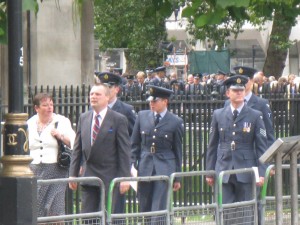
The weird thing for me was that the tourists and “commoners” were queued up just gawking at these people, like they were another parade. We all moved to one side to let them pass, and everyone just stared. And they stared back! It was like a zoo. Granted, there were a lot of tourists there, and I feel that some allowances must be made for foreigners who are prone to gawking at everything. But the fact that the upper class stared back at us was really unsettling because I feel like we shouldn’t have been that interesting. I mean, we were just a crowd of regular people. But everyone automatically gave deference to the upper class filing out from the Abbey, which was also interesting to see.
I’m interested to see how classism manifests itself at UEA, because my friends who have studied in England have assured me that it’s definitely there. They said that students will judge each other by where they come from and that there won’t necessarily be outward hostilities, but that everyone will know where their friends or flatmates stand in terms of class. I haven’t decided yet if I should practice smashing my peas onto the back of my fork.
Tags: 2010 Holly
September 19th, 2010 · No Comments
Hailing from a small New England town tucked away in the white mountains of New Hampshire, I’m quite familiar with “green space.” I am actually more unaccustomed to living anywhere even close to a big city. Nearest to home is Boston—a two hour and fifteen minute haul. Therefore, one significant change in living in London is the disappearance of the monstrous mountains, endless trees, and, of course, fresh, crisp air. However, this wondrous city never ceases to surprise me. The parks I have visited are, as many can agree, blessed sanctuaries. I unintentionally have separated the innumerable parks into two groups: the larger, well known ones and the smaller, more secluded ones. Each sort of park provides a different environment.

New England’s expansive green space (personal photo)
Of the “royal” parks (they’re labeled as such on London’s website) I have enjoyed Hyde Park and its nearby neighbor, Kensington Gardens; the Green Park, St. James’s Park, and the Reagent’s Park. It is at times entertaining to get lost in these massive parks. As a person wanders, he or she delves deeper into the green refuge and furthers him or herself from the city’s bustle and grime. I enjoyed exploring the incalculable monuments, memorials, and museums that materialize in these sprawling parks. These sanctuaries are not just for people to escape the city chaos; they serve as a safe place to preserve the surrounding area’s detailed history. I researched Hyde Park extensively and the pride the Londoners hold for the history of the park and the area itself is immediately evident. Speaker’s Corner, Rotten Row, Serpentine, the Wellington Museum—they all are housed within Hyde Park to be preserved and honored. For one, Hyde Park Corner Tube Station boasts tunnels decorated with elaborate murals illustrating the area’s history. How that for an introduction?

Hyde Park
The smaller parks have their own benefits. Scattered throughout the city and hidden in unexpected areas of London, these parks also present its community with an opportunity to take a break from the stresses of life. Although, they seem to enact stricter regulations, the parks offer a one with a place for relaxation, tranquility, entertainment, and community. Not to say these features do not apply to the larger parks, but these small parks seem much more intimate and more closely connected to the residents of the area. Also, these parks oftentimes possess a number of historical monuments but to a lesser degree in comparison to the royal parks. Even so, all of these parks in London, regardless of their size, give people a place to take a break from city life or just life in general. And to me, I particularly like that each one prides itself on its distinctive, detailed history.

Bedford Square, the park just down Gower Street
Tags: 2010 Mary
September 19th, 2010 · No Comments
The fact that London is 25% green absolutely boggles my mind. I love that the English place such an emphasis on green open areas, even in the middle of their capital. One of my favorite days during our trip here incorporated an afternoon in Regent’s Park. After my walking tour I went to the park, armed with a book and a sunny day. I then sat there for an hour and read. And while I did not get much actual reading done, I experienced something far more important – the breakdown of English cultural barriers. It started when someone’s puppy wandered over to me. Instead of calling back their dog, the owner just smiled at me and kept going, trusting that I would respect their pet and that it would go back to its owner when it so desired. This complete warmth towards a total stranger is not something I had experienced yet in the usually reserved London public sphere.
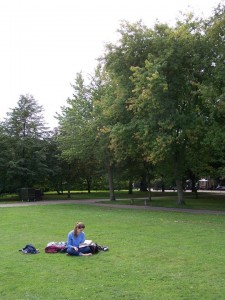
This breakdown of reserve was apparent the more I walked around the park. Everywhere I looked there were older gents playing with their dogs, mothers entertaining their children, and couples walking around paying more attention to each other than to their beautiful surroundings. While Kate Fox always talks about the English “social dis-ease” the atmosphere of Regent’s park was completely the opposite. Both at Regent’s Park and at St. James’ Park the wealth of examples of the English comfort, not with just themselves, but with those around them, showed more warmth than I am accustomed to in Los Angeles. It is almost as if the British use their parks as a place to escape the normally tight social boundaries regarding affection and interaction with strangers.
Parks also serve to remind the English that they’re inherently country folk. In times of crisis throughout English history (like the Plague), those who could afford to would flock to the countryside and to their agrarian roots. The English find safety in green open spaces and in city filled with smog and where everyone is in a constant rush, there has to be an emphasis these parks. These parks help make London English and help to remind English Londoners that they are English.
Tags: 2010 Amy
September 19th, 2010 · No Comments
As we have all noticed, pubs are an integral part of English life. They also make for a good laugh when walking down the street and you realize a particularly bizarre pub name. My experiences in pubs thus far have been varied and I’ve learned a few things.
#1: You can’t care if people are looking at you funny because you’re loud. A couple of times, I’ve been with a group of people and we have been rather loud, not surprisingly. Of course it attracts attention, especially if has been in the earlier part of the day. For example, after the walking tours were finished, my group went to a pub (The Globe) outside of Covent Garden to have a celebratory drink. An older couple was sitting near us and I’d notice that they sent us side glances every once in awhile. (In our defense, we did try to sit in a back corner so that we wouldn’t- hopefully- be too disturbing.) While we were being loud, I have noticed on my other pub visits that loud isn’t always a problem. It’s a space where people can be more relaxed and English reserve is often lessened. So, I was left wondering whether the side-glances were a result of the fact we were loud Americans (typical!), 20-somethings, or a combination of both.
#2: The Irish are more outgoing, supposedly. A couple of weeks ago, I was in a pub when an Irish guy (James) started to talk to us (and constantly complained about how the English are a lot more stand-offish, as well as about how I don’t have a strong accent). At this point, I had this idea of pubs as solely a place for mates to get together to catch up or after work to wind down. Instead of being the ones who attempted to start a conversation, we were engaged, which caught me off guard. Afterwards, I was hoping that maybe some of the other experiences that I had at pubs would be more open. Nope. They reinforced the idea that this was an exception to the rule.
#3: Offering a pint is polite, but so is refusing. When I’ve been in groups and we’ve offered to a drink to the bartender, they’ve either accepted and then not charged us or refused us. In the later example, I think she was so caught off guard that we offered. The last time we were in this particular pub, we had been in a hurry and unable to “play by the pub rules.” This and her surprise at the offer because of the fact most tourists don’t know about this particular bit of pub etiquette is what, I think, played a major role in her refusal. I look forward to seeing what happens in other pubs.
#4: Don’t be in a hurry. Pubs are a place to relax and unwind with friends, not grab a quick bite between activities. They are meant to be places where time slows and happiness increases, not where stress creeps through.
#5: Orwell was right. The perfect pub doesn’t exist. I’ve enjoyed visiting different ones, but I haven’t found my ideal English pub where I want to go back and become a regular, that has my favorite cider, the best chips in the world, little rooms where no one disturbs anyone, interested workers, near a tube/bus stop, and that the worst drunks don’t visit. Yet, I think the perfect pub would lose its charm. One of the great things about the different pubs I’ve encountered so far is that they all have their charm and I would want to return for different reasons. If you take all of the traits that I’ve enjoyed the most and put them into one pub, I think I’d find it boring.
I look forward to continuing the quest for my perfect pub. I’m thinking the name will be something along the lines of the Unicorn of Albion…
Tags: 2010 Stephenie · Pubs
September 19th, 2010 · 2 Comments
In America I have always had the feeling that one thing or one aspect you do not talk about at school is religion and your personal religious beliefs. I believe this stems from the thought that people’s feelings will be hurt, that it is too personal. I say “rubbish” to that way of thought, if there is one thing I have appreciated on this trip is the amount of religious discussions we have had in our group. Never had I had full on discussion about religions and my own personal religious beliefs with my own peers before this month. So, I would like to take the time so say Thank you Britain for allowing us to be a little bit more open in our beliefs.
Throughout this month we have visited a number of Cathedrals, Churches, and Religious Centers. As a Catholic I definitely identified more with the Cathedrals and Churches we visited. My favorite of these was St. Paul’s Cathedral. It is a magnificent structure that really attests to the power and might of humans. When I see gorgeous structures like St. Paul’s I always wonder how a great architects mind, like Christopher Wren, see when they see an empty space. People who are born with the ability to express through creation always impress me and make me just a little bit jealous.
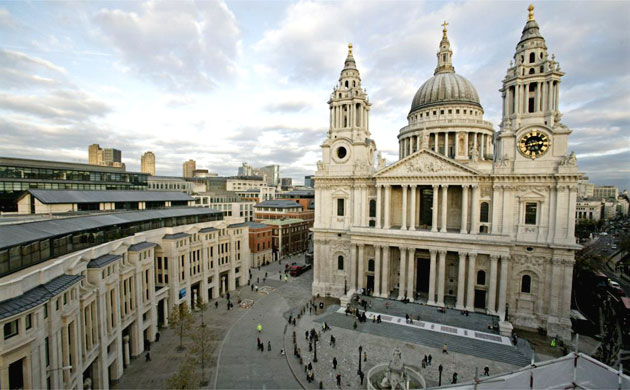
On other note I was really uneasy and uncomfortable with Britain transforming these Cathedrals and Churches from spiritual dwellings into semi- museums. I feel it makes them very impersonal and looses a little bit of its beauty. However, on the other hand it is also a way for people of different sects and beliefs to learn and experience these religions. I guess with every decision made there is a positive and a negative.
After seeing all these really old places where kings and queens were crowned we moved on to religions that I know little to nothing about. The first of which was the Mandir. Let me just say that before this day I had never even seen what a Hindu place of worship looks like or known much about the religion. I was surprised to see another magnificent place of worship, with such high precision of architecture. The religion itself is radically different from what I am use to but nonetheless I felt welcomed and curious at the same time. Perhaps, what struck me the most was the fact that in the place of worship and veneration women and men are separated.
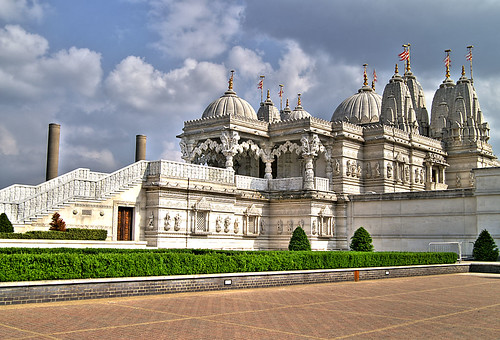
After the Mandir we visited a Mosque in the East End. Unlike my learning experience within the Mandir I felt my opportunity to learn about Islam and the community was lost in such a quick and impersonal tour. The Mosque was pretty well developed but the interior was not as interesting as I had expected it to be. I was actually excited to wear a head covering to visit this temple just because I had never been required to do it.
The last place of worship we visited was a Synagogue. This was not my first visit to a Jewish temple but it was very different to my last experience. In my last experience I attended an actual service and I had to go through security check prior to entering the premises. In the actual services I felt like a complete outsider I hardly knew what was going on. This time, however, we were expected. We did not have to go through security and were given a very comprehensive lesson on the history of Jewish people in England. All around it was a great experience.
From all my visits to these largely different and sometimes similar sects of religions I came to my own conclusion about religions in general. Religions will always be necessary as long as man live. Religions were at first the first form of government for communities stipulating how to act, how to work, how to live as a unit, etc. Now religions provide for man a sense of purpose beyond our own physical existence, they attempt to explain the unexplained, to give hope, to give a sense of identity, and lastly to create a sense of community. Therefore, I think that all religions will continue to existence as long as man lives.
Tags: 2010 Jamie







